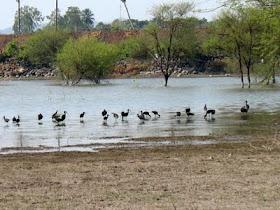The Glossy Ibis (Plegadis Falcinellus) is a wading bird and is the most widespread of the Ibis family.
For feeding, the Ibis probes in the mud and silt with its bill looking for prey like the fiddler crab, freshwater shrimp, insects and small snakes.
For feeding, the Ibis probes in the mud and silt with its bill looking for prey like the fiddler crab, freshwater shrimp, insects and small snakes.
The Glossy Ibis nests as part of a colony in trees, and often shares with other water birds such as Herons. In flight, the Ibis flies gracefully in a straight line or V-formation with its neck outstretched.
This bird is migratory and a colony of 40-50 are currently resident at Samudram Erie where they have been since the end of last year
Video of Ibis Feeding
This bird lays 3-4 eggs in a nest of twigs and sticks usually built in trees or bushes but rarely on the ground. It builds its nests in colonies that includes other Ibises as well as the nests of different species such as Egrets and Herons. Occasionally, the Glossy Ibis will use an abandoned nest. The Ibis is very territorial during nesting.
The Ibis has a bleating call during breeding season but at other times is usually silent. Eggs take about three weeks to hatch. The female and male incubate the egg, but the female does most of the work. Both parents feed the chicks. The chicks fledge in about a month. They leave the nest and start to forage for food with their parents when they are two months old.

This bird is about 20 inches tall with a wingspan of about three feet. It has a long, dark gray bill that is curved down. Breeding adults have reddish-brown bodies and shiny bottle-green wings. Non-breeders and juveniles have duller bodies. This species has a brownish bill, dark facial skin bordered above and below in blue-gray (non-breeding) to cobalt blue (breeding), and red-brown legs.
To view more photographs and videos go to this link here.




No comments:
Post a Comment